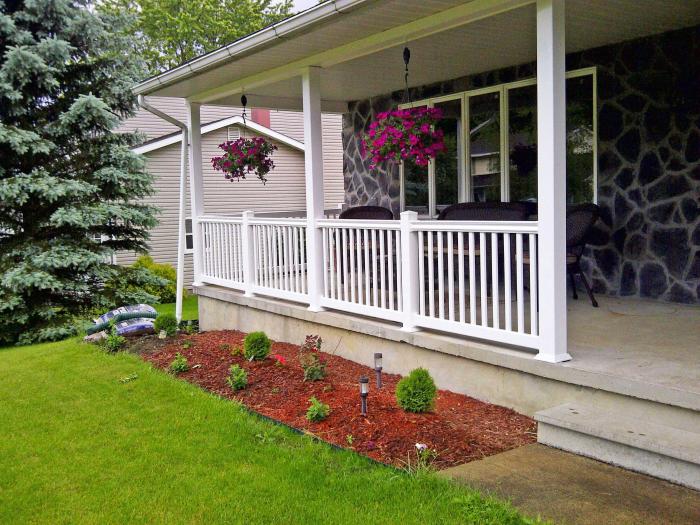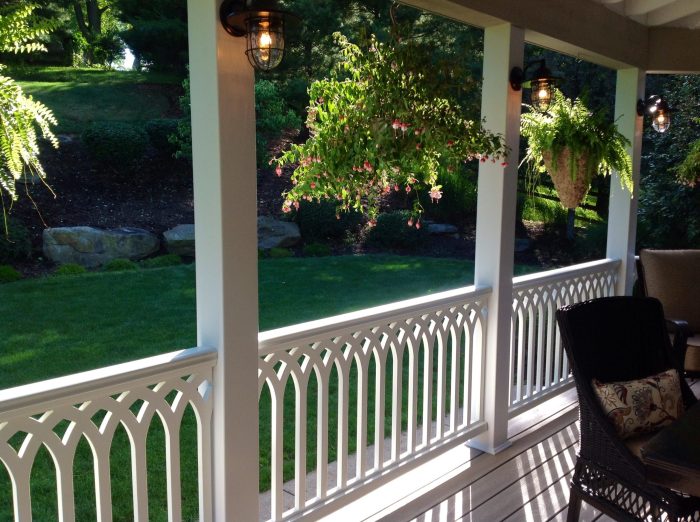As the heart of your outdoor space, your porch deserves a touch of elegance and functionality. Porch railings play a pivotal role in defining the aesthetics and safety of your porch, creating an inviting atmosphere while ensuring the well-being of your loved ones.
With a myriad of styles and materials available, selecting the perfect porch railing can be an overwhelming task. This comprehensive guide will navigate you through the diverse world of porch railing styles, providing valuable insights to help you make an informed decision.
From traditional balustrades to modern cable railings, each style offers unique characteristics and advantages. Understanding the nuances of each design will empower you to create a porch that seamlessly blends with your home’s architectural style and reflects your personal taste.
This guide will also explore the pros and cons of various materials, ensuring durability and longevity for your outdoor sanctuary.
Porch Railing Styles
Porch railings serve both functional and aesthetic purposes, enhancing the safety and curb appeal of your outdoor space. Various styles are available, each with unique characteristics and features.
Traditional Porch Railings
- Balusters: Vertical spindles or posts connected by a top and bottom rail.
- Turned Balusters: Balusters with decorative turned designs, adding an elegant touch.
- Square Balusters: Balusters with a square cross-section, providing a clean and modern look.
Modern Porch Railings
- Horizontal Rails: Rails running parallel to the ground, creating a sleek and minimalist appearance.
- Cable Railings: Cables strung between posts, offering a transparent and unobstructed view.
- Glass Railings: Panels of tempered glass, providing a modern and sophisticated look.
Rustic Porch Railings
- Log Railings: Logs or branches used as railings, creating a natural and cozy ambiance.
- Twig Railings: Thin twigs woven together, adding a touch of whimsy and texture.
- Wrought Iron Railings: Ornate ironwork, providing a classic and timeless appeal.
Other Styles
- Composite Railings: Made from a combination of materials like wood and plastic, offering durability and low maintenance.
- Vinyl Railings: Durable and easy to clean, available in various colors and styles.
- Aluminum Railings: Lightweight and rust-resistant, suitable for coastal areas.
| Style | Pros | Cons |
|---|---|---|
| Traditional | Elegant, timeless | Can be labor-intensive to maintain |
| Modern | Sleek, minimalist | May lack privacy |
| Rustic | Natural, cozy | Can be less durable than other styles |
| Composite | Durable, low maintenance | May not have the same aesthetic appeal as natural materials |
| Vinyl | Durable, easy to clean | Can be prone to fading or warping |
| Aluminum | Lightweight, rust-resistant | Can be more expensive than other styles |
Materials for Porch Railings
When choosing materials for porch railings, it is important to consider factors such as durability, maintenance, cost, and aesthetics. Different materials offer unique advantages and disadvantages, making it essential to carefully evaluate each option before making a decision.
Wood
- Advantages: Wood is a classic and versatile material for porch railings, offering warmth and natural beauty. It is durable, can be stained or painted to match any decor, and is relatively easy to repair.
- Disadvantages: Wood requires regular maintenance, such as staining or painting, to protect it from the elements. It can also be susceptible to rot and insect damage if not properly treated.
- Examples: Cedar, redwood, and pressure-treated pine are popular wood choices for porch railings.
Metal
- Advantages: Metal railings are durable, low-maintenance, and resistant to rot and insects. They are also available in a variety of styles and finishes, making them suitable for any home decor.
- Disadvantages: Metal railings can be more expensive than wood or vinyl railings, and they can be hot to the touch in direct sunlight. Additionally, they may require occasional painting to maintain their appearance.
- Examples: Aluminum, wrought iron, and stainless steel are common metal choices for porch railings.
Vinyl
- Advantages: Vinyl railings are low-maintenance, durable, and resistant to rot and insects. They are also available in a variety of colors and styles, making them a versatile option for any home.
- Disadvantages: Vinyl railings can be more expensive than wood or metal railings, and they may not be as strong as other materials. Additionally, they can fade or discolor over time.
- Examples: PVC and composite materials are common vinyl choices for porch railings.
Design Considerations for Porch Railings
Designing porch railings involves striking a balance between safety, aesthetics, and functionality. Consider these factors:
Safety
- Height: Typically 36 inches high for residential applications, ensuring protection against falls.
- Spacing: Vertical balusters should be spaced no more than 4 inches apart to prevent entrapment.
- Grip: Handrails should be comfortable to grip, with a diameter of 1.5 to 2 inches.
Aesthetics
Match the railing style to your home’s architectural style. Consider:
- Traditional: Balusters with decorative details, such as spindles or scrollwork.
- Modern: Clean lines and geometric shapes, often using metal or glass.
- Rustic: Natural materials like wood or stone, with a rugged or weathered appearance.
Functionality
- Purpose: Determine if the railing is primarily for safety or also for seating or decoration.
- Access: Ensure easy access to the porch, especially for those with limited mobility.
- Maintenance: Choose materials that are durable and easy to maintain.
Examples of Well-Designed Porch Railings
Well-designed porch railings enhance the safety, aesthetics, and functionality of your outdoor space. Here are some examples:
- Traditional: White picket fence railing with decorative scrollwork on a colonial-style home.
- Modern: Black metal railing with horizontal bars on a contemporary home.
- Rustic: Log railing with natural bark on a cabin-style home.
Installation and Maintenance of Porch Railings
Installing porch railings involves several steps: planning, measuring, cutting, and assembling. Proper planning includes determining the style, height, and material for your railings. Measuring involves taking precise measurements to ensure the railings fit correctly. Cutting involves using the appropriate tools to cut the railings to the desired length.
Assembling involves connecting the railings to the porch and to each other using nails, screws, or bolts.Maintaining your porch railings is crucial to ensure their longevity and safety. Regular cleaning, inspection, and repairs are essential. Cleaning involves removing dirt, dust, and debris from the railings.
Inspection involves checking for any signs of damage, such as loose or broken parts. Repairs involve fixing any damage promptly to prevent further deterioration.
Creative Ideas for Porch Railings
Porch railings offer a fantastic opportunity to add character and style to your outdoor space. Here are some creative ideas to inspire you:
From classic designs to modern innovations, there’s a wide range of porch railing styles to choose from. Whether you prefer intricate scrollwork or sleek geometric lines, you can find a railing that complements your home’s architecture and your personal taste.
Unique and Innovative Porch Railing Designs
- Cable Railings: These railings use thin cables strung between posts to create a modern and minimalist look. They offer unobstructed views and allow plenty of light to pass through.
- Glass Railings: Glass panels create a sleek and sophisticated look while maintaining transparency. They’re perfect for maximizing natural light and creating an open and airy feel.
- Pergola Railings: Pergola railings feature a latticework design that creates a charming and inviting atmosphere. They can be customized with climbing plants or flowers to add a touch of greenery.
Latest Trends in Porch Railing Design
- Mixed Materials: Combining different materials, such as wood, metal, and glass, adds visual interest and depth to porch railings.
- Asymmetrical Designs: Breaking away from traditional symmetry creates a unique and eye-catching look. Experiment with different post heights, shapes, and spacing.
- Lighting Integration: Incorporating LED lights into porch railings enhances safety and creates a warm and inviting ambiance.
Last Point
Designing and installing porch railings is an art that requires careful consideration of safety, aesthetics, and functionality. By embracing the knowledge and inspiration provided in this guide, you can transform your porch into a captivating and secure outdoor retreat. Whether you prefer the timeless charm of wood or the sleek sophistication of metal, the perfect porch railing awaits your discerning eye.
Remember, your porch is an extension of your home, a place where memories are made and moments are cherished. Invest in a railing that not only protects but also enhances the beauty and enjoyment of your outdoor haven.



